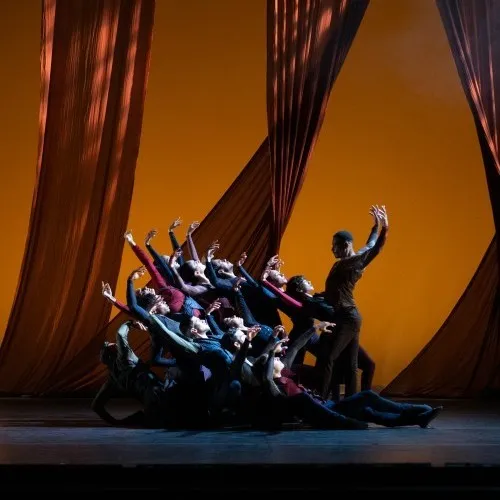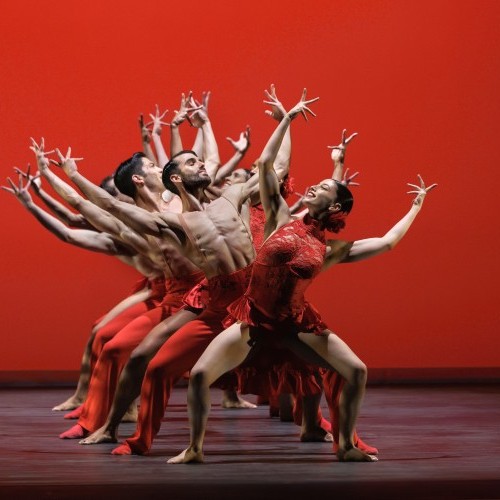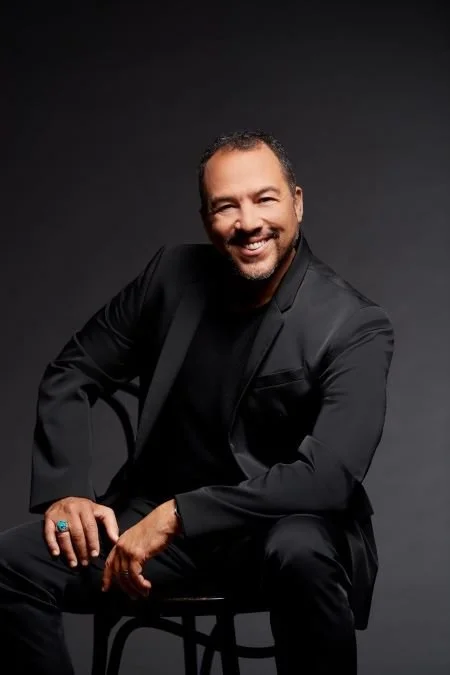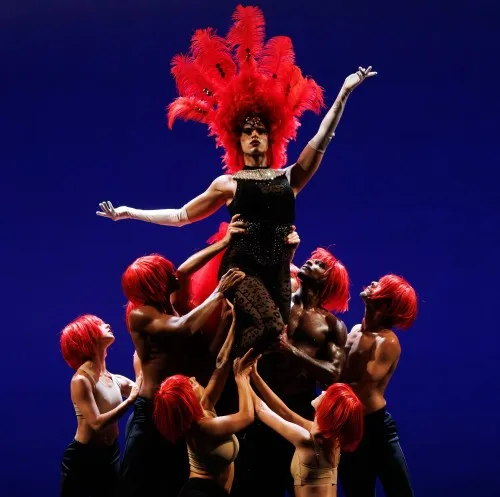Choreographic works encompassing a tongue-in-cheek reflection upon the sacred and profane cultural dimensions of the many representations of Maria in Latin America, an inspired commentary on sancocho through the story of a 17th-century Afro-Hispanic painter who was an enslaved artisan to a Spanish master artist and a balletic celebration of Cuban music and dance styles in the 1950s comprise the upcoming thrilling triple-bill for Ballet Hispánico’s performance this week in Salt Lake City.
As part of UtahPresents’ touring dance trio package for the 2025-2026 season, Ballet Hispánico will perform Oct. 15 at 7:30 p.m. in Kingsbury Hall at The University of Utah. A New-York-City-based titan in the American dance community which has commissioned more than 100 works, the company recently celebrated its 55th anniversary and has been recognized by the Ford Foundation as one of America’s Cultural Treasures.
Founded by Tina Ramirez, Ballet Hispánico is a pioneering entrepreneurial archetype of creative placemaking, established in the tailwinds of the civil rights movements in the Sixties. In an interview with Brenda Dickson Gottschild for an article that was published in a 2001 dance history reader, Ramirez explained how the company’s name came to be when it was founded in 1970: “At that time, people didn’t know what Hispanic meant— not even the Hispanics. I was criticized for calling the company Ballet Hispánico. People felt I should name it after a country or a city or a town. But I said no, because we’re 21 nations that all speak Spanish— and we should all be included…my purpose was to create better understanding between Hispanics and non-Hispanics and what better way than through dance and through art?”
In an interview with The Utah Review, Eduardo Vilardo, of Cuban heritage and who succeeded Ramirez as artistic director in 2009 and later assumed as well the CEO responsibilities for Ballet Hispánico, said the ideals of making a Latino community place for dance in New York City sprung from a “need for survival.” Despite the forces of gentrification, the white flight to the suburbs, urban buildings and neighborhoods falling into dilapidated states and declines in community services for Black and Latino communities in the city, the pursuit of dance illuminated the essential halo effects extending beyond the idea of art just for the sake of art.
The Alvin Ailey American Dance Theater was established in 1958, Harlem Dance Theater was founded in 1969 and then Ballet Hispánico in 1970, setting up an ecosystem that has flourished to this day. “These pioneers built these towers of dance not only as spaces of safety but also as economic engines that gave artists the opportunities for jobs as well as ways to support their families and fundamentally create abundance,” Vilaro explained. Fifty-five years later, that revolutionary spirit of resilience is just as potent and relevant, as arts companies reckon with a new hostile, contentious chapter in history surrounding the legacies of colonization, immigration, assimilation and globalization.
Vilaro danced with the company from 1985 to 1996 and then went to Chicago where he formed the Luna Negra Dance Theater. In the 16 years he has been at the helm of Ballet Hispánico, the essential mission is intact but it also has flexed in ways that also are familiar to many Utah dance companies, where dance as a performing art wears the empress crown of jewels.
In the creative process of setting choreography, dancers are seen as active collaborators. Ballet Hispánico offers, for example, Instituto Coreográfico, a lab that offers Latino, Hispanic, Latinx choreographers the comprehensive background to make their own creative entrepreneurial mark. The Pa’lante scholarship program offers opportunities for BIPOC pre-professional students to expand their training and prepare for their professional careers. Dialogos is an ongoing series of forums on dance, culture and social justice.
Salt Lake City is Ballet Hispánico’s fifth stop on a six-city October tour. The company will perform a recently restaged version of a work by Annabelle Lopez Ochoa that premiered in 2010, a 2024 piece by Vilaro and one of its most popular crowd pleasers that premiered in 2000.
Anchored in the exploration of stereotypes and representations of icons, Ochoa’s House of Mad’moiselle builds upon the duality of sacred and profane dimensions of the ubiquitous Maria in many of its manifestations. It is a personal work for Ochoa, part-Colombian who spent her formative years in Belgium, and only later learned Spanish in her life. The piece takes audiences initially from the vantage of an ingénue to other Marias who contribute layers that reflect the complexities of femininity and gender identity, which defy numerous stereotypes, some of which were propelled by the contradictory challenges of Marianismo.
Vilaro’s Buscando a Juan is inspired by the life of the Afro-Hispanic painter Juan de Pareja, who was enslaved by the Spanish painter Diego Velázquez for more than two decades before becoming an artist in his own right.
Using music composed by Osvaldo Golijov, Vilaro situates the work not just as an homage to an unsung artist but also as a penetrating meditation on the historical scope of slavery that has been visible through virtually every period of human civilization.
Until very recently, Pareja was known by an often-circulated myth, as arts writer Shanti Escalante-De Mattei summarized: ”Velázquez, a favorite of King Philip IV, resided in court along with his dutiful slave de Pareja. Unknown to him, Pareja was making paintings in secret. One day the art-loving king stumbled upon Pareja’s surreptitious labor and demanded that he be freed, declaring that, “The man who had such talent cannot be a slave.” The key to unlocking more about Pareja’s actual circumstances came when Jennifer Montagu, an art historian, discovered the artist’s manumission document.
Vilaro was especially moved when the artist’s work was featured in a critically acclaimed exhibition in 2023 at the Metropolitan Museum of Art. In 17th century Seville, enslaved artisans were as common as ordinary apprentices but Pareja’s position was unique, given that Velázquez was so highly regarded by the king that the artist was permitted to take Pareja on his European travels.
After Velázquez died, Pareja, as Escalante-De Mattei explained in her ArtNews focus, stayed on in Velázquez’s studio, if only to make ends meet. “Over the course of his career as a free man, he painted large, flowery religious scenes: the Virgin Mary surrounded by cherubs at the moment of immaculate conception, the baptism of Christ, the flight of the Holy Family to Egypt,” she wrote. ”In one particularly stunning work, The Calling of Saint Matthew (1661), Pareja inserted a self-portrait at the left edge of the painting, the figure holding a slip of paper with his name on it.”
Evoking the scenes of nightclubs in Havana in pre-Castro days, Pedro Ruiz’s Club Havana has been acclaimed for its choreographic opulence as a showstopper. In its quarter century since its creation, the work has been featured prominently. In 2016, Lincoln Center at the Movies: Great American Dance presented the work as a film in select theaters. In 2017, PBS broadcast the film nationally in celebration of Hispanic Heritage month.
Ruiz, a Cuban immigrant who danced as a principal with Ballet Hispánico for twenty-one years, choreographed the piece. The piece shows plenty of romantic clichés and stereotypes of machismo and misogyny, but when it is pitched against, for example, the two other works that Ballet Hispánico will perform, it is important, as Vilaro notes, also not to negate that part of the history in order to contextualize how heritages have evolved and progressed.
For tickets and more information, see the UtahPresents website,




